Choosing the perfect paint color for your living room can be an exciting yet overwhelming task. Your living room is a central space in your home, where family gatherings, relaxation, and entertaining guests happen.
Getting the right shade can transform the entire mood of the room. Here’s a comprehensive guide on how to pick a living room paint color that aligns with your style, enhances your space, and leaves you feeling inspired. We can help turn your inspiration into a reality with our interior painting services!
- Assess the Mood You Want to Create
- Consider the Lighting in Your Living Room
- Complement Your Existing Furniture and Décor
- Use Color Psychology to Guide Your Decision
- Don’t Be Afraid to Test Paint Samples
- Consider the Size of the Room
- Decide Between an Accent Wall or Full Room Color
- Use a Color Palette
- Trust Your Instincts
- Frequently Asked Questions About Living Room Paint Colors
- Final Thoughts on Choosing the Perfect Living Room Paint Color
Assess the Mood You Want to Create
When choosing a paint color for your living room, start by thinking about the atmosphere you want to establish. Your living room is a place where you’ll spend a lot of time, so it’s important that the color reflects the mood you want to create. Different colors evoke different emotions:
Warm tones like reds, oranges, and yellows are inviting and energizing, making them ideal for social living rooms where you want to foster conversation and excitement.
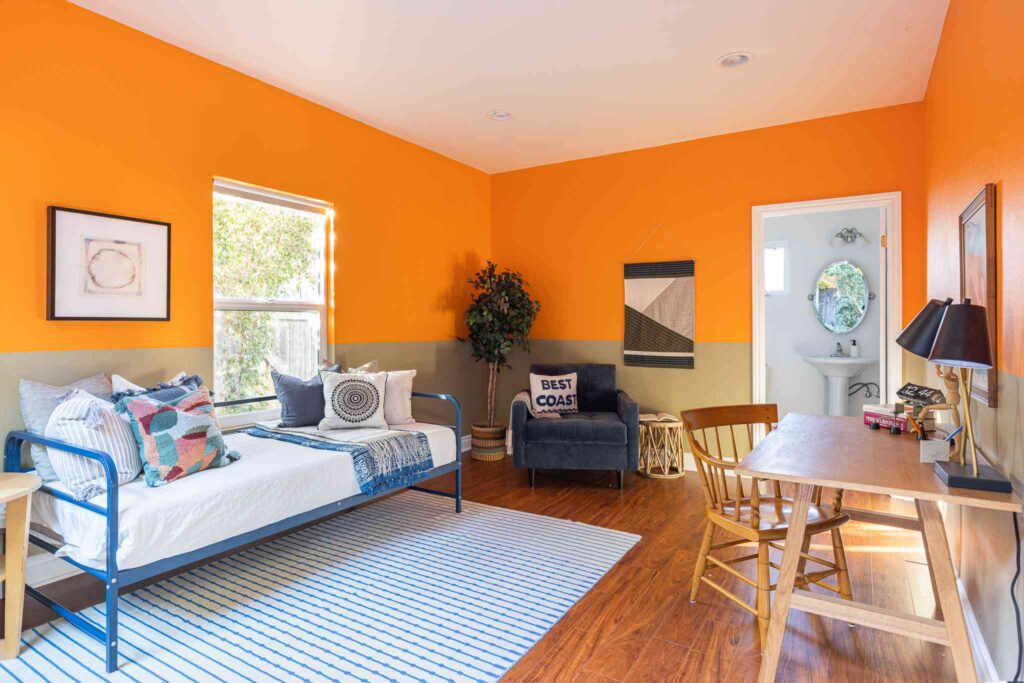
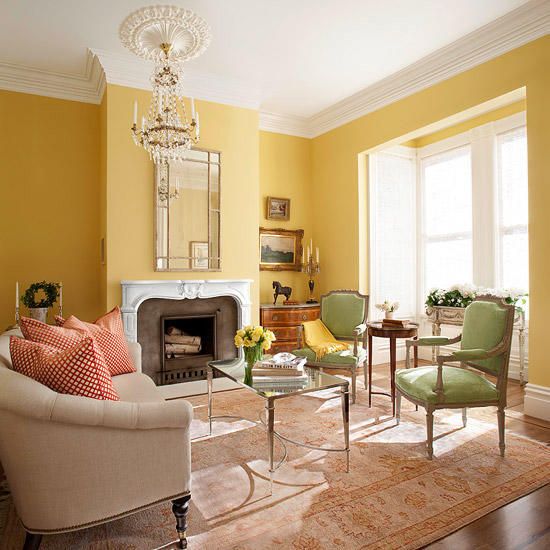

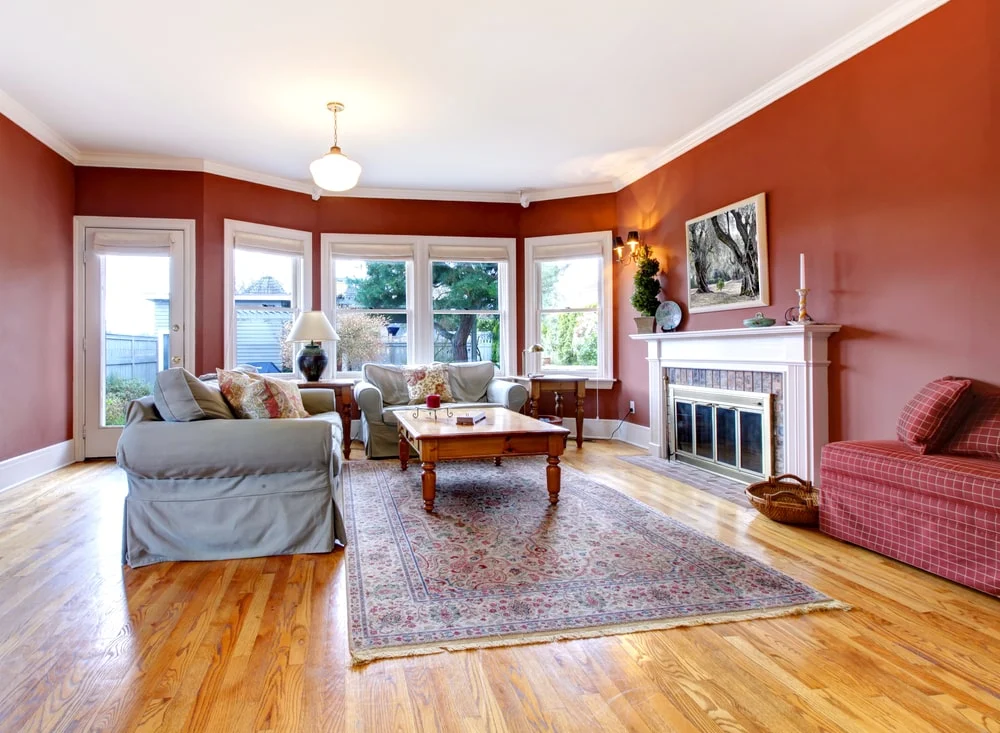

Cool tones like blues and greens offer a calming, relaxing environment, perfect if your living room is more of a retreat.
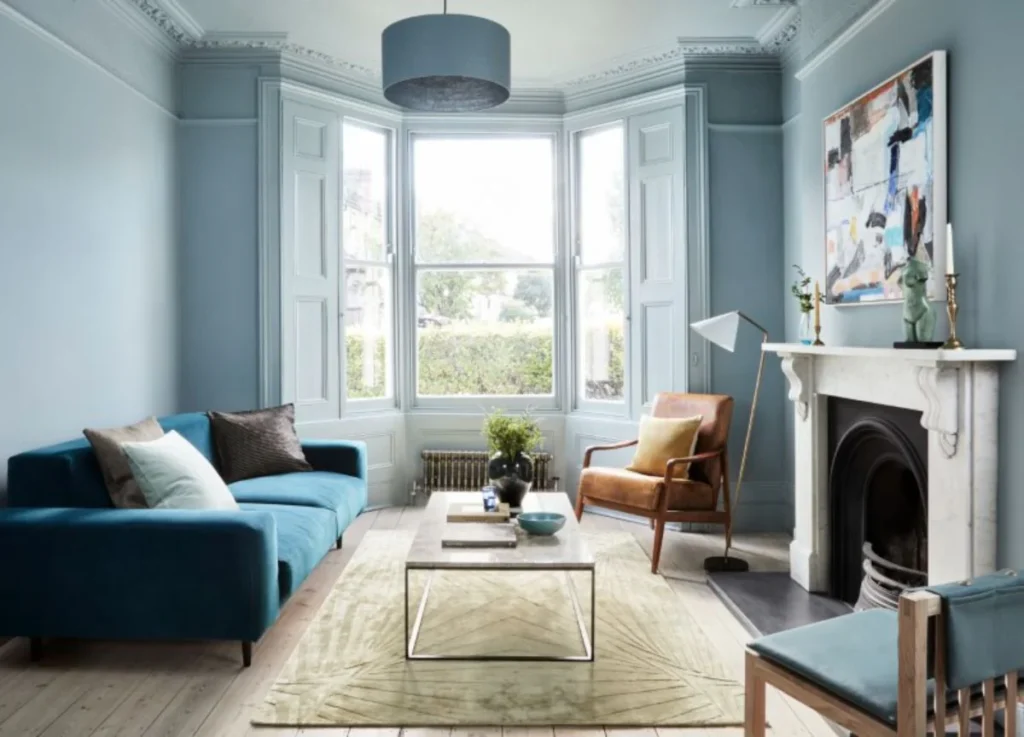

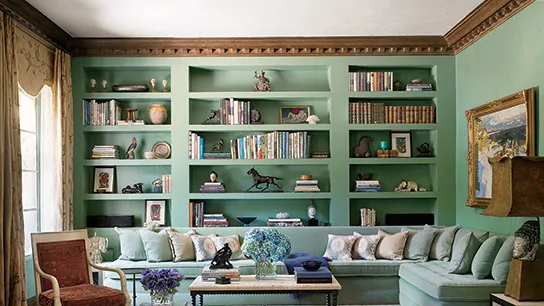

Neutrals such as whites, grays, and beiges are versatile and timeless, offering a blank canvas that allows other elements of the room, like furniture or artwork, to take center stage.
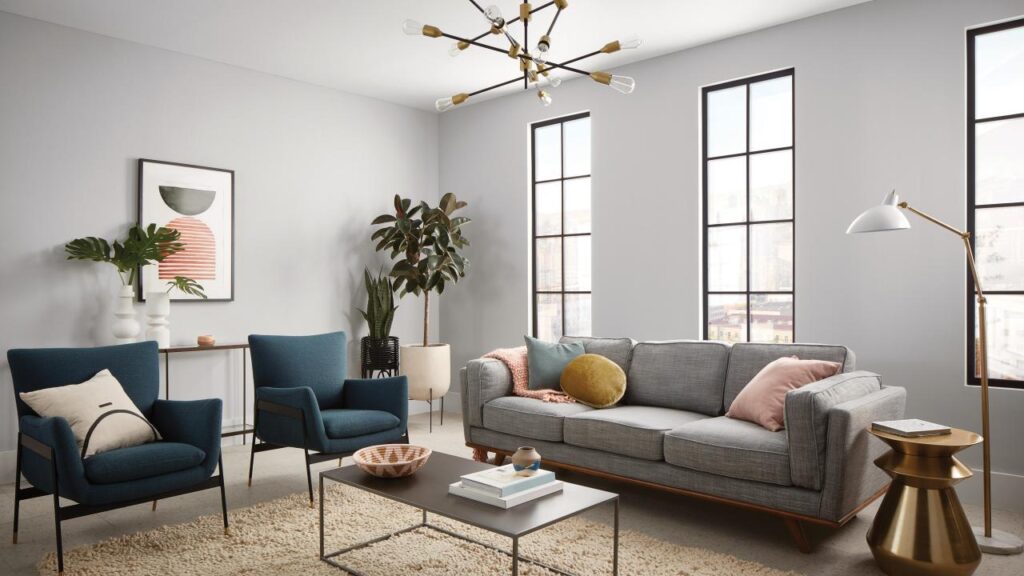

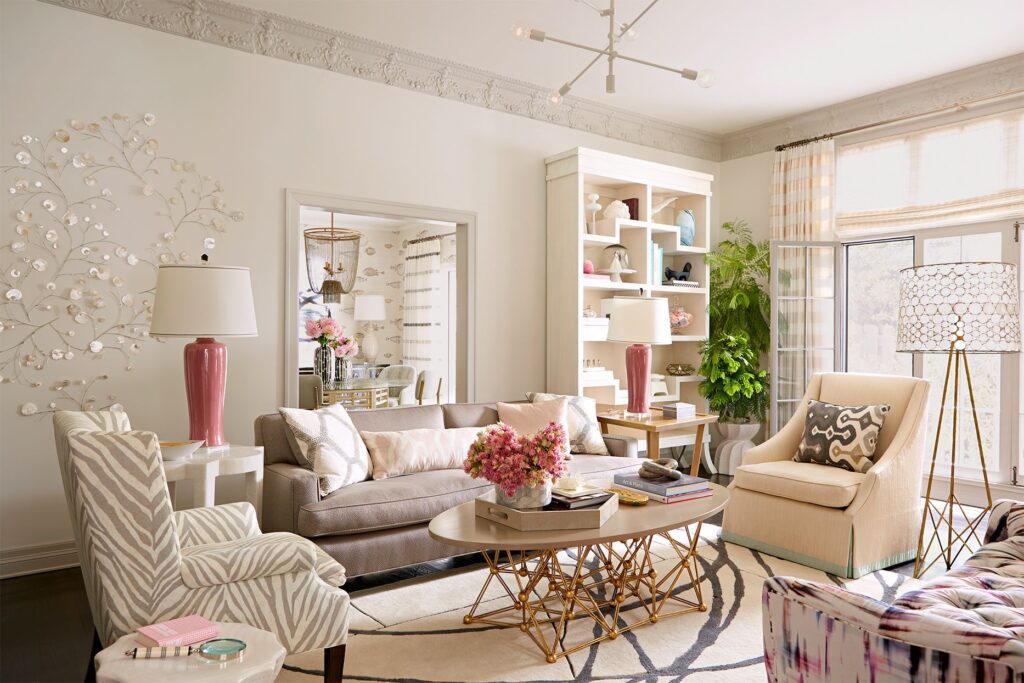

Knowing the mood you want can help narrow down the options as you select the right paint color for your living room.
Consider the Lighting in Your Living Room
Natural and artificial lighting can dramatically affect how a paint color appears in a room. The same color can look different in the morning versus evening light, and it may appear one way under soft, warm lighting and another under bright, cool lighting.
- Natural light: Rooms that receive a lot of sunlight will show paint colors in their truest form. For bright spaces, you might want to avoid overly bold or vibrant colors, as they can feel overwhelming in direct light.
- Artificial light: The type of artificial lighting in your living room—whether it’s incandescent, fluorescent, or LED—can impact how your chosen color appears. For example, warm lighting tends to enhance yellow and red tones, while cool lighting brings out blues and greens.
- North vs. south-facing rooms: Rooms that face north tend to have cooler, softer natural light, so warmer paint colors can balance this. South-facing rooms receive stronger sunlight, and cool tones can work well to temper the warmth.
Before committing to a paint color, observe how it interacts with your living room’s natural and artificial light sources throughout the day.
Complement Your Existing Furniture and Décor
Another key factor in how to pick a living room paint color is considering your existing furniture, décor, and artwork. Your paint color should complement these elements, creating a cohesive design that flows seamlessly throughout the room.
- Contrast: If you have bold furniture or vibrant décor, choosing a neutral paint color allows these pieces to stand out without overwhelming the space.
- Harmony: If your furniture and décor are more subdued, consider using a bold or contrasting paint color to add energy and visual interest to the room.
- Accents: Think about the room’s accent colors. If you have pillows, throws, or artwork that feature certain hues, you can either match or complement them with your living room paint color. This will create a unified aesthetic that feels intentional and polished.
Use Color Psychology to Guide Your Decision
Understanding the psychology behind colors can also help inform your paint selection. Different colors elicit different feelings and behaviors. Here’s a quick rundown of how some common living room colors can influence the space:
- Blue: A popular color for its calming effects, blue is ideal for creating a serene and relaxing living room. Light blues can make a room feel spacious and airy, while darker blues lend a sophisticated, cozy vibe.
- Green: Associated with nature and tranquility, green is a great choice for a balanced, peaceful living room. Soft sage greens feel fresh and soothing, while deeper emeralds create a dramatic, lush effect.
- Yellow: Cheerful and uplifting, yellow brings warmth and happiness into a space. However, in large doses, it can feel overwhelming, so it works best as an accent or in lighter shades like buttery yellows or soft golds.
- Gray: Versatile and modern, gray provides a neutral backdrop that works with almost any décor style. Whether you go for a warm greige or a cooler slate gray, this color can add sophistication and depth to your living room.
- White: Crisp, clean, and classic, white makes a room feel open and bright. It also allows you to play with textures and patterns in your furniture and décor without clashing with the paint color.
Don’t Be Afraid to Test Paint Samples
Once you’ve narrowed down your choices, testing paint samples is an important next step in deciding how to pick a living room paint color. Paint a few swatches on different walls in your living room and observe how they look at various times of the day and under different lighting conditions.
- Large swatches: The bigger your test swatches, the better. Aim for at least a two-foot square so you can see how the color will read across a significant portion of the wall.
- Live with it: Don’t rush the decision. Give yourself a few days to live with the paint samples on the wall and evaluate how they make you feel over time. You’ll have a better sense of which color resonates with you after seeing it throughout different times of the day.
Consider the Size of the Room
The size of your living room can also influence the best paint color for the space. Lighter colors can make small living rooms feel more open and airy, while darker colors can make large rooms feel cozier and more intimate.
- Small living rooms: Opt for light shades such as soft grays, whites, or light blues to make the room feel more spacious and less cramped.
- Large living rooms: In a larger living room, you can afford to go bold with deeper shades like navy blue, charcoal gray, or even a rich forest green. These colors will add warmth and coziness to an otherwise open and expansive space.
Decide Between an Accent Wall or Full Room Color
If you’re struggling to decide on a color or want to experiment with a bold choice, consider incorporating an accent wall. Painting one wall in a standout color allows you to introduce vibrancy into your living room without overwhelming the entire space.
- Accent walls: Use a bold or contrasting paint color on one wall to create a focal point. This works particularly well if you have a large piece of furniture, like a sofa, or a striking piece of artwork that you want to highlight.
- Full room color: If you love the color and feel confident about committing to it, painting all the walls the same shade creates a unified, immersive look. Just make sure the paint color harmonizes with the room’s furniture, lighting, and overall design.
Use a Color Palette
One of the best ways to ensure your living room paint color is cohesive with the rest of your home is by choosing a color palette. A color palette is a set of colors that work well together, typically including a mix of neutral, complementary, and accent shades.
- Monochromatic palettes: If you prefer a minimalist look, stick to variations of a single color, using different shades and tints to add depth and interest.
- Complementary palettes: Use opposite colors on the color wheel, such as blue and orange or yellow and purple, to create a bold, dynamic look.
- Analogous palettes: Choose colors that are next to each other on the color wheel, like green and blue or red and orange, for a harmonious, serene look.
Trust Your Instincts
At the end of the day, the best way to pick a living room paint color is to trust your instincts. While there are plenty of guidelines and tips to follow, you’re the one who will be spending the most time in the space. If a color excites you, go for it! Your living room should be a reflection of your personality, and choosing a paint color that resonates with you will make it a space you’ll love for years to come.
Frequently Asked Questions About Living Room Paint Colors
What color should I choose for my living room?
It depends on your style, but soft neutrals like beige or gray are always a safe bet. If you want to get creative, add a splash of bold color like navy or green for extra personality!
What is the most popular paint color for a living room?
Lately, shades like greige (a mix of gray and beige) and light gray are super popular for living rooms. They’re neutral, modern, and go with almost anything.
What is the most relaxing color for a living room?
Soft blues and greens are known for their calming vibes. They can make your living room feel like a peaceful retreat after a long day.
What is the most popular living room color for 2024?
For 2024, earthy tones like terracotta and warm beige are trending big time. These colors make your living room feel cozy and grounded.
What is a happy color for a living room?
Yellow is the ultimate happy color—it’s bright, cheerful, and brings a lot of energy to your space. If yellow feels too bold, try a softer shade like pastel yellow or peach.
Which color is positive for living room?
Green is often considered a positive color because it represents balance and harmony. Plus, it brings a bit of nature indoors, which is always refreshing!
What two colors go well together in a living room?
A classic combo is navy blue and white, which creates a crisp, clean look. Another great pair is gray and mustard yellow for a fun, modern vibe.
How to choose wall color for living room?
Start by thinking about the mood you want—calm, cozy, or energetic. Then, consider how much light your room gets because darker colors might make it feel smaller, while lighter colors open it up.
What are the most calming colors for living room?
Soft blues, gentle greens, and light grays are some of the most calming colors. These shades help create a soothing, peaceful atmosphere.
What is the going color for a living room?
Earthy, natural tones like beige, terracotta, and olive green are super popular right now. They add warmth and make your living room feel inviting and cozy.
Which color shade is best for a living room?
Light to medium neutral shades like soft beige, gray, or greige are perfect for living rooms. They create a versatile backdrop that works with almost any decor style.
Final Thoughts on Choosing the Perfect Living Room Paint Color
Selecting the perfect paint color for your living room is a rewarding experience when you approach it with a blend of creativity, planning, and practicality. By assessing the mood, considering lighting, and complementing your décor, you’ll be well on your way to choosing a paint color that not only looks great but also enhances the ambiance of your home. Don’t forget to test samples and trust your instincts when making the final decision, and your living room will be beautifully transformed with the perfect paint color.